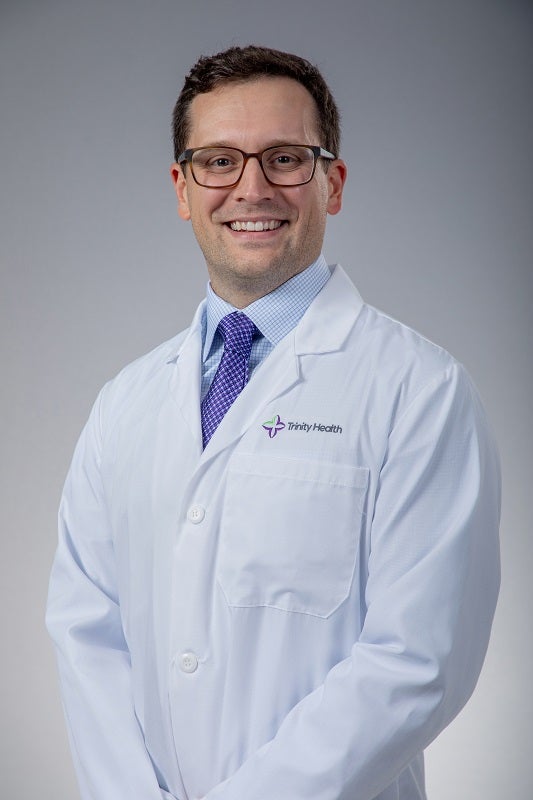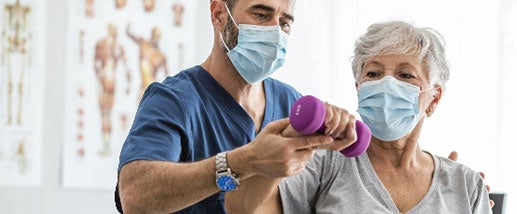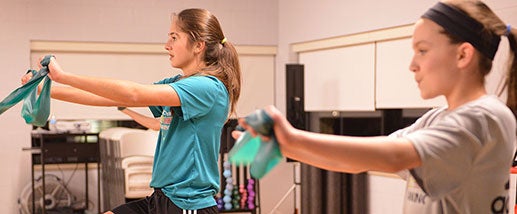It Was Not the Kind of Life I Wanted in Retirement
July 9, 2025Sharon Vanlente, 71, admits that sitting at a desk all those years while working did not help her knees. She had been suffering in pain for years but did her best to ignore it. So, when she decided to retire at age 70, Sharon realized she could no longer ignore her pain.
“I could barely walk,” she said. “I knew I needed to do something. It was not the kind of life I wanted in retirement.”
Sharon’s Trinity Health primary care provider referred her to Orthopedic Surgeon Kevin Steelman, MD.
“He is a young, quiet, and very nice person,” said Sharon. “He explained everything and told me that both knees were bad and needed to be replaced.”
“Sharon had severe deformity in both knees; she was bowlegged,” said Dr. Steelman. “She also had severe bilateral knee osteoarthritis. Once we fixed the first knee, she began to walk on that with her straightened leg — but the other was still crooked, so she was very eager to get the other side done. We were able to replace both knees within a few months,” he added.
Sharon’s Pre-Surgical Preparation
Sharon worked for years in a doctor’s office, so she understands that some people don’t like to move because of pain. She saw many patients resign themselves to a life confined in a wheelchair. Determined to achieve the best outcome, she proactively decided to strengthen her weak legs prior to surgery.
“I live near a gym in Walker,” said Sharon. “I spoke to a trainer about my surgery, and she helped me prepare for it. I strengthened my muscles, worked my quads, and did a lot of stretches.”
Robotic Knee Replacement
In January, Sharon had her left knee replaced by Dr. Steelman using Mako SmartRobotics™ technology. Between his residency and fellowship, he has performed more than 500 robotic-assisted surgeries with the Mako robot.
“Not every patient requires robotic-assisted total knee replacement, rather than manual total knee replacement,” said Dr. Steelman. “But there can be advantages to using the Mako robot, especially in complex cases, such as Sharon’s.”
“I’m glad I had the robot,” Sharon said. “Dr. Steelman explained that they had a new technology that would make his cuts more precise. He told me that they loaded my CT scan into the robotic software the day of surgery. Knowing that gave me the confidence to do the surgery. Everything went very smoothly.”
For Sharon, there were clear advantages to using Mako robotic technology. “Before surgery, we were able to use robotic technology to determine the size of the knee implant required and anticipate any intraoperative challenges, such as bone cysts, defects, or spurs,” said Dr. Steelman.
“During Sharon’s robotic-assisted surgery, the robot was able to stress her bowed knees, which told me which parts were tight or loose with a high level of accuracy. I was then able to digitally manipulate the implants to balance her knee without releasing any tendons or ligaments. This helps to decrease postoperative pain and swelling. The robotic arm also allows me to be more precise and efficient in the OR,” he added.
Sharon’s Post-Surgical Regimen
Sharon was determined to experience newfound freedom following her knee replacement.
“Your instructions are to get up and walk, and I did that using a walker and, later, a cane,” she said. “I had some post-operative pain, but I was able to handle it with the medication. There is a big difference between pain and discomfort. I mostly experienced discomfort, and I think that is because I kept moving.”
Sharon’s physical therapist and surgeon were impressed with her quick recovery.
“I think that had to do with my exercise before the surgery and the fact that after surgery I didn’t stay in bed,” she said.
Her recovery was so impressive that, in April, she had her right knee replaced, just three months following her first surgery.
The Importance of Physical Therapy
“If you don’t do physical therapy, you won’t recover,” Sharon said with passion. “It is so important. I had a very good experience with my physical therapist. She listened to me, and she knew what she was doing.”
After completing the physical therapy prescribed following her second surgery, Sharon is back at the gym working out. She has a walking trail behind her residence, which she enjoys regularly. She also goes rock hunting at the beach. Before her surgeries, she was unable to do either of these activities.
What does Sharon especially like about her new knees? “Being able to walk around the house, to get out, to do daily activities like driving without pain. Now I can do whatever I want to do. And my legs aren’t bowed anymore. They are straight!”
Parting Advice
Both Dr. Steelman and Sharon urge people with knee pain to seek medical care.
From Dr. Steelman: “The Mako robotic technology is tried-and-true. It has been around for many years and is predictable. For some patients, it can be very advantageous. It offers us another tool to give our patients the best possible outcomes after joint replacement surgery.”
From Sharon: “Remember, you have to do your part. You have to get up and move. In the long run, you will be glad you did.”
At Trinity Health Michigan, we offer both traditional and robotic-assisted surgical options for joint replacement, designed to help you regain mobility and live pain-free.
Let our orthopedic experts help you take the next step toward lasting relief. Learn more and request an appointment today.




